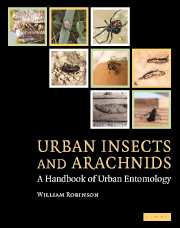Book contents
- Frontmatter
- Contents
- Preface
- Part I Urban entomology
- Part II Insects in the urban environment
- 4 Blattaria
- 5 Coleoptera
- 6 Collembola, Dermaptera
- 7 Diptera, Ephemeroptera
- 8 Hemiptera, Homoptera
- 9 Hymenoptera
- 10 Isoptera
- 11 Lepidoptera
- 12 Mantodea, Neuroptera
- 13 Orthoptera, Phasmatodea
- 14 Phthiraptera
- 15 Plecoptera, Psocoptera
- 16 Siphonaptera
- 17 Thysanoptera, Thysanura, Trichoptera
- Part III Other arthropods in the urban environment
- Family, genus, species index
- Index
- References
12 - Mantodea, Neuroptera
Published online by Cambridge University Press: 06 August 2009
- Frontmatter
- Contents
- Preface
- Part I Urban entomology
- Part II Insects in the urban environment
- 4 Blattaria
- 5 Coleoptera
- 6 Collembola, Dermaptera
- 7 Diptera, Ephemeroptera
- 8 Hemiptera, Homoptera
- 9 Hymenoptera
- 10 Isoptera
- 11 Lepidoptera
- 12 Mantodea, Neuroptera
- 13 Orthoptera, Phasmatodea
- 14 Phthiraptera
- 15 Plecoptera, Psocoptera
- 16 Siphonaptera
- 17 Thysanoptera, Thysanura, Trichoptera
- Part III Other arthropods in the urban environment
- Family, genus, species index
- Index
- References
Summary
MANTODEA
Introduction
Praying mantids are primarily tropical insects, and there are about 1800 species in eight families worldwide. They are characterized by an elongate prothorax and modified front legs. Front coxae are long and mobile, and the front femora and tibiae usually have strong spines, and flex for grasping prey. Legs are held in front of the head, simulating an attitude of prayer, which is the origin of the common name. They are predaceous on living insects. There may be an elaborate premating sequence, and the male usually approaches the female with caution. In some instances the female in copulation turns around and devours the participating male. Females of some species use a pheromone to attract males.
Eggs are laid in batches of 12–400 in an eggcase, which begins as a frothy liquid but hardens into a tough fibrous protective structure after the eggs have been deposited in it. The shape and placement of the eggcase are characteristic for each species. Most mantids spend the winter or tropical dry season in the egg stage; however, Empusa spp. overwinter as nymphs. There is usually one generation per year in north temperate regions, but several in the tropics. Adults and nymphs are found on trees and ornamental plants around buildings; some species fly to lights at night.
Mantidae
Species in this family are exclusively carnivorous and occur in all warm regions of the world.
- Type
- Chapter
- Information
- Urban Insects and ArachnidsA Handbook of Urban Entomology, pp. 346 - 349Publisher: Cambridge University PressPrint publication year: 2005



